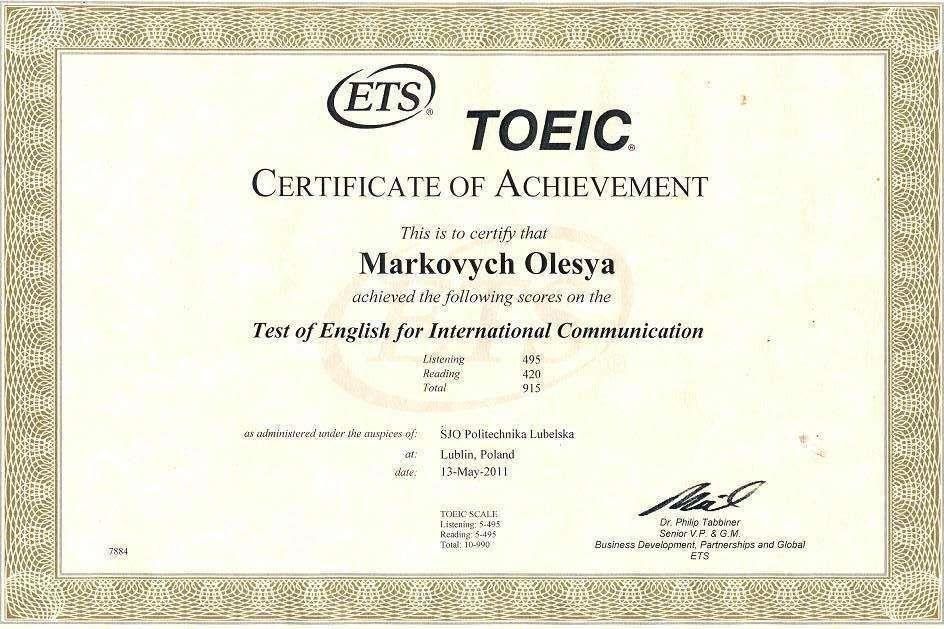

Where does the TOEIC certificate apply, test structure and tips for passing the exam.








Test of English for International Communication (TOEIC) — is an English language proficiency exam designed for individuals seeking employment in English-speaking international companies. While the TOEIC test shares similarities with the TOEFL exam in terms of structure, their main distinction lies in their respective purposes.
The TOEFL exam primarily serves academic objectives, such as gaining admission to foreign educational institutions or participating in scientific symposiums and conferences. On the other hand, the TOEIC exam aims to assess English language skills in an international work setting. This exam evaluates one's ability to deliver effective presentations, engage in business meetings, and conduct negotiations in English. Obtaining a TOEIC certificate is crucial for those aspiring to build a successful career in international business.
The TOEIC exam consists of two separate sections — Speaking & Writing and Listening & Reading. The first section lasts 80 minutes, while the second lasts 120 minutes.
Test takers have the option to take each part separately or together, depending on their preferences. Many individuals choose to only take the Listening & Reading section, which is often sufficient for working in international firms. Notably, the test tasks are based on real-life work situations.
There are 100 tasks in this section, for which 45 minutes are given.
The reading section also has 100 tasks, but the time for it is longer — 75 minutes.
There are 11 tasks in the section, the total time to complete is 20 minutes.
It is important to follow the instructions for each part to perform well and achieve a high score. The candidate’s speech will be audio-recorded and assessed by multiple examiners, who will evaluate various aspects such as pronunciation, coherence, intonation, vocabulary, and grammar. The Speaking section has a maximum score of 200 points.
The Speaking section consists of six parts:
In total, there are 8 tasks in the section, 20 minutes are given for them. The section consists of 3 parts:
Each part of the exam is evaluated independently, and a separate certificate is awarded for each. The TOEIC Listening & Reading certificate is widely recognized and popular today.
| Part | Section | A1 | A2 | B1 | B2 | C1 |
|---|---|---|---|---|---|---|
| 1 | TOEIC Writing | 30 | 70 | 120 | 150 | 180 |
| 1 | TOEIC Speaking | 50 | 90 | 120 | 160 | 180 |
| 2 | TOEIC Listening | 60 | 110 | 275 | 400 | 490 |
| 2 | TOEIC Reading | 60 | 115 | 275 | 385 | 455 |
In total, you can get from 10 to 990 points for the Listening & Reading exam. The tone scale is as follows:
| TOEIC Listening & Reading | Level |
|---|---|
| 120–224 | A1 |
| 225–549 | A2 |
| 550–784 | B1 |
| 785–944 | B2 |
| 945–974 | C1 |
| 975–990 | C1+ |
The TOEIC Listening & Reading certificate is significant to employers, as it reflects the candidate's performance on the exam. The certificate is color-coded based on the number of points earned:


| Website | Description |
|---|---|
| Englishteststore | Website offering over a dozen free online tests for preparation |
| Quizlet | Learning materials and flashcards to help with studying business idioms |
| Ets.org | Official TOEIC website |
| Englishclub | Examples of answers for the oral part of the TOEIC exam |
| Goodlucktoeic | Useful information about the exam and study materials |
Listening & Reading exam:
| Service | Cost |
|---|---|
| TOEIC | 134 USD / 166 USD |
| Duplicate score report | 9 USD |
| Courier service for sending test results | 21-45 USD |
Speaking & Writing exam:
| Service | Cost |
|---|---|
| TOEIC | 160 USD |
| Duplicate score report | 32 USD |
If you cancel the registration for the test more than 3 weeks before the exam date, the money will be returned. In case of late notification or failure to appear for the test, the Testing Center withholds money.
Understand the structure of the test
Before starting your preparation, familiarize yourself with the TOEIC exam structure. If you are focusing on the Listening & Reading test, practice completing tasks that improve your reading comprehension and understanding of English texts. Reviewing past test examples will help you approach typical problems more effectively.
Set goals
Establish clear goals for your TOEIC exam. Determine the minimum score required for your desired position or admission to a business school. For instance, employment in an international company may require a score of at least 800, while university admission may require a minimum of 600 points. Setting realistic goals is essential.
Plan your studying
Avoid procrastinating your exam preparation until the last days or weeks, as it often leads to unsuccessful results. Start your preparation as early as possible, regardless of when you registered for the TOEIC exam. Consider a combination of independent study and working in a team under the guidance of a teacher. Ensure your study materials provide accessible explanations for answers. Recommended study resources include Barron’s 600 Essential Words for the TOEIC, Kaplan TOEIC, Barron’s TOEIC Test with Audio CDs, Longman Preparation Series for the New TOEIC and Cracking the TOEIC with Audio CD.
Be reasonable with time management
Identify your weaknesses through trial tests and allocate study time accordingly. Avoid spending excessive time on one section and evenly distribute your focus to address your weak areas. Divide your study week into sections, dedicating specific days to vocabulary practice, writing skills, and other key areas.
Expand your vocabulary
A limited vocabulary is a common reason for exam failure. Keep a dictionary handy to note down unfamiliar words encountered during preparation. However, refrain from translating every word, as time is limited during the exam. Instead, learn to deduce word meanings from context. Focus on learning business vocabulary related to work, travel, events, and other relevant topics.
Trust your intuition
In some instances, there may be questions that seem both right and wrong. Trust your intuition and avoid changing answers multiple times, as it consumes valuable time. Concentrate on new tasks and return to difficult questions later if time permits (applies to the paper version of the test).
Avoid literal translations
Encountering unfamiliar words is common during the exam, but translating everything is not feasible within the given time constraints. Learn to guess word meanings based on context instead. Using a dictionary during the exam is not allowed.
If necessary, guess the answer
When unsure, it is better to guess rather than leaving a question unanswered. Guessing is permitted in the TOEIC exam, and no points are deducted for incorrect answers, similar to the SAT exam.
Save time
Avoid spending excessive time on one section to ensure you complete all test tasks. Proper time management is crucial, and the goal is to finish all tasks within the given time frame. If time allows, you can revisit difficult questions at the end.
Listen to fast audio
Develop the skill of understanding spoken English during your preparation. During the exam, there will be no opportunity to replay questions or recordings. Train yourself to grasp the meaning of the spoken content the first time it is presented. Additionally, you have limited time to provide your answers, so do not dwell on the previous question when the next one is being announced.
Read aloud
Improving your understanding of spoken English is vital and can be achieved by reading English literature aloud. This practice helps improve perception of speech and understanding the rhythm of the language. Consider reading modern newspapers, magazines, brochures, and publications related to business topics. Additionally, listening to TV shows and lectures from reputable universities available online can enhance your speaking skills. Learning real-life English used in daily business communication is essential.
Take practice tests
Numerous trial tests are available online for free. Take advantage of these to assess your current level of knowledge, identify strengths, and pinpoint areas for improvement. It is advisable to take a trial test before and after your preparation to gauge progress. Official practice tests provided on the TOEIC website offer insights into the exam structure and help familiarize you with typical questions.
Learn with a native speaker
Even if you cannot afford individual tutoring, language learning platforms offer opportunities to connect with native English speakers who are eager to learn other languages. Engaging with a native speaker can help improve your English skills and provide a chance to make new friends.
Learn new material without cramming
Avoid cramming new material the night before the exam. Allow yourself ample time to rest and sleep before the test to ensure a fresh mind. Start your test day with a nourishing meal to avoid distractions from hunger. Dedicate the week prior to the exam for reviewing previously studied material.
Manage your anxiety
Test-takers often experience doubts and anxiety about their knowledge and abilities before the exam. Maintain a positive mindset — this is not your last opportunity. You can retake the test if needed. Register for the exam a few months before your desired employment or business school admission, allowing flexibility for retakes if necessary.
The TOEIC exam does not require specific vocabulary knowledge in particular areas like finance or economics. Instead, it evaluates overall preparedness to communicate effectively within a business environment. This is where its complexity lies. The exam tasks encompass a wide range of topics, including team communication, memo preparation, company budget planning, shopping, and travel. It may also cover questions about booking tables in restaurants, organizing corporate events, and renting rooms. Hence, TOEIC preparation courses are suitable for individuals with advanced English proficiency.
Thousands of organizations around the world trust the results of the TOEIC exam. It opens doors for employment at international companies, higher education opportunities abroad, and participation in international training programs. Additionally, including a successful TOEIC result on your English resume enhances your credentials.
Exams are the main criterion for selecting students at most universities around the world.
UniPage specialists will help to find an experienced tutor who will prepare you for successful passing of international exams.
